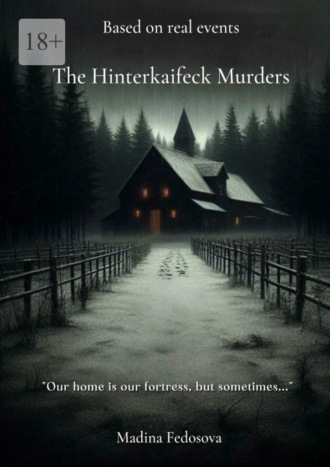
Полная версия
The Hinterkaifeck Murders
To the left of the road, as far as the eye could see, were carefully cultivated plots of land, neatly sown with grain. The even rows of ears, swaying under gusts of wind, created an impression of peace and prosperity.
On the right stretched the forest, gloomy and silent, like a living creature lying in wait for its prey. Its dense crowns, shielding the sun, cast long, sinister shadows on the ground. It seemed that invisible eyes were hidden in the depths of the forest, watching your every step. The silence of the forest was deceptive; it only emphasized its sinister character.
The wind, piercing and cold, blew from the fields, penetrating under your clothes and making you shiver. It whistled in your ears, drowning out all other sounds, but at times, through this whistle, strange, frightening sounds came from the forest. Either the howl of wild animals, or the whisper of ancient trees, or the moans of lost souls. These sounds filled you with anxiety and a premonition of trouble, making you look around for danger. Every step you took along this road brought you closer to the Hinterkaifeck farm, to a place where horror and despair awaited you.
It was there, to that windy spruce, three hundred and fifty meters after the turn from Eibergstrasse, that you should direct your gaze. There, in the shadow of the spruce, was the point where the world ended and the nightmare began. And where the Hinterkaifeck farm was hidden, awaiting you in chilling silence. It was a place where the blood-soaked earth kept its terrible secrets.
The exact time of construction of the Hinterkaifeck farm, unfortunately, is not recorded in any documents available to researchers. Time has taken its toll, and many archives have been lost or destroyed. However, judging by the preserved fragmentary information, photographs, and eyewitness descriptions, as well as by the architectural style of the building, it can be assumed with a high degree of certainty that the farm was probably erected in the late 19th or early 20th century, during a period of active development of agriculture in Bavaria.
The building was a typical farmhouse for Bavaria at that time: a two-story structure, built of durable stone and wood, materials available in this area. Stone provided strength and durability to the structure, and wood was used for the construction of floors, walls, and the roof.
Hinterkaifeck was arranged in such a way that its inhabitants could live and work without practically leaving the complex. The residential house, outbuildings, and even the barn were connected into a single unit, forming a complex system of passages and corridors. This created a sense of seclusion and security, but at the same time made the farm vulnerable. It was thanks to this isolation and the ability to move between buildings without going outside that the perpetrator was able to carry out his plan, remaining unnoticed for a long time.
The roof of the farm was covered with red tiles, laid in the traditional Bavarian style. The tiles protected the house from the weather, keeping it warm in winter and cool in summer. The roof had a steep slope, which allowed snow to slide down easily, without creating additional stress on the structure.
The house was closely adjoined by outbuildings necessary for farming and providing for the life of the farming family: a spacious barn for storing hay and grain, a stable for keeping horses and other domestic animals, a shed for storing agricultural implements, and other auxiliary premises, such as a wood shed, a chicken coop, and a pigsty.
All these buildings formed a single complex, closely connected with the life of the farming family, providing them with everything necessary for survival and prosperity. The Hinterkaifeck farm was not just a house, but a whole world, in which the life of several generations of Bavarian peasants unfolded.
The Hinterkaifeck farm, like many other peasant farms in Bavaria, was most likely built by one of the members of the Gruber family, which owned it for several generations, passing it from hand to hand, from father to son, from grandfather to grandson. This was the land of their ancestors, the roots of the family, the source of their life and well-being. They invested their labor, their hopes, their dreams in this land.
The location of Hinterkaifeck was relatively secluded. There was a decent distance to the nearest houses, and several kilometers to the village of Groben itself. Due to its remoteness, the farm was quite isolated from the surrounding world. A narrow dirt road, surrounded by forest, led to the farm. This created a sense of detachment from the outside world, which played a fateful role in the tragic events of the spring of 1922. The farm was far from busy highways and transport routes, which made it difficult to access and made it vulnerable.
The farm itself, if you could see it in those last peaceful days, was a huge, austere stone structure, shaped like a giant Latin letter «I». The living quarters, spacious and probably well-furnished, made up the main part of the house, while the stable and barn adjoined them under one roof. Thus, everything necessary for living and working on the farm was under one roof, in close interweaving. This, combined with the remoteness of the farm, created an atmosphere of self-sufficiency and isolation.
Outside, order reigned in a large open courtyard, paved with rough stone slabs. On the left, a small shed stood separately, serving as both a bakery and a laundry room. Its chimney rose above the roof, spreading the aroma of freshly baked bread, which, however, was never felt in the house again. In the courtyard adjacent to the main building, there were sheds for storing hay, as well as enclosures for livestock, creating a scene familiar to a peasant yard. Everything was in its place, familiar and calm.
And yet, despite its apparent reliability and durability, Hinterkaifeck seemed to exude a certain gloom, as if it harbored an unspoken secret. On quiet evenings, when the sun set over the horizon and a thick shadow enveloped the forest, it seemed that the walls of the farm were compressing, and invisible observers were hiding in the dark corners.
The attic seemed particularly sinister. The creaky floorboards, the whisper of the wind in the cracks, and the bizarre shadows cast by the moonlight created the feeling that something invisible and unkind lived there. Sometimes at night, strange sounds came from there – either a rustle or a creak, which made the blood run cold in your veins.
And although the Gruber family had grown accustomed to this gloomy atmosphere and had learned not to pay attention to the strange sounds, an inexplicable fear lurked in the depths of each of them. Fear of the dark, of the forest, of what is hidden in the shadows.
Hinterkaifeck seemed to be waiting for something. Waiting for its hour to reveal its terrible secret. And this hour was approaching with every minute, with every creak of the floorboards, with every rustle in the forest.
Chapter 5
The House Where the Light Goes Out
The Hinterkaifeck farm, immersed in the Bavarian outback, belonged to the Gruber family. It was said that they lived in prosperity – the land was fertile, the livestock was well-groomed. But money, as you know, does not always guarantee peace.
The Grubers were not loved by their neighbors. They lived reclusively, as if guarding some secret, and this always causes suspicion. They were shunned, whispered about behind their backs, called strange, even sinful. As if the shadow of an ancient curse lay on the farm.
Few documents about the Grubers have survived, memories are vague, and rumors… rumors are painted in dark colors. It was felt that something was wrong in this house, that something dark was hidden behind the external decency. As if behind the locked doors of Hinterkaifeck, its own sinister drama was unfolding, which no one was supposed to know about.
The Grubers lived as if in a besieged fortress, cut off from the world not only by the stone walls of the farm, but also by an invisible wall of alienation. Rarely was anyone seen at village festivals or in church; they did not share their joys or sorrows with their neighbors. And the neighbors, admittedly, did not particularly strive for communication, trying to turn to them only in case of extreme necessity. As if they felt that something unkind was in the air in Hinterkaifeck, that it was better to stay away from this place.
The only exception was Viktoria, the daughter of Cäzilia and Andreas. This tall, slender girl, unlike her parents, did not shun the outside world. She was the thread that connected Hinterkaifeck to the surrounding villages. Viktoria went to school in Weidhofen, where, albeit reluctantly, she communicated with other children and teachers. These few hours away from the farm were a breath of fresh air for her, a rare opportunity to feel part of ordinary life.
On the way to school, and sometimes on household chores, Viktoria sometimes exchanged a couple of words with the postman or passing merchants. These conversations were short and formal, but even they served as a thin thread connecting her with the outside world, reminding her that she was not completely forgotten. Helping around the house and rare visits to church services also gave her the opportunity to escape, albeit briefly, from the oppressive atmosphere of the house.
Viktoria was mostly spoken of well – sweet, quiet, with a beautiful voice. She was a pretty girl, but there was a strange detachment in her appearance. It seemed that she lived in her own world, cut off from the cruel reality surrounding her.
It was said that her angelic singing in the church choir seemed to atone for the sins committed within the walls of the farm. But even in church, in a holy place, Viktoria could not completely relax, as if she was afraid that Andreas’ shadow would catch up with her there. She feared her father like fire, never contradicted him, avoided his gaze, and unquestioningly carried out all his orders. But even this did not save her from anger – the bruises, carefully hidden under her clothes, were an eloquent testimony to the cruelty that reigned in Hinterkaifeck. Viktoria was not the only child of Cäzilia, but she was the only one of all the children who lived to adulthood. The older sister, unable to withstand life in this cursed place, married and left, leaving Viktoria alone with her fear.
And so, at the age of 27, fragile and broken, she continued to live in a house where cruelty and violence reigned, dreaming of a salvation that never came… Her home was more like hell, and there was almost no hope that she would escape from this hell.
The neighbors’ opinions often differed from what the Grubers themselves saw. And one of those who had known this family for many years was Kurt Wagner, who lived on a neighboring farm:
Kurt Wagner’s Testimony.
Having lived on a neighboring farm and known the Gruber family for many years, he left heavy memories of Andreas Gruber and the living conditions of the children. In his testimony, he stated that, in his opinion, the child probably died due to a lack of proper care and insufficient nutrition. Wagner also claimed that he and his father often heard the children being locked in the basement for several days when they passed by the farm. In conclusion, he added: «I’ll tell you frankly, these people were not good.»
Little information about them has survived to this day, as if time and human memory were trying to erase their names from the face of the earth. And those grains of information that have reached us, for the most part, are negative. It seems that history itself is trying to warn us, saying that something terrible was hidden behind this prosperous facade.
Testimony of Hermann Bauer:
In a statement submitted to the police in 1922, Hermann Bauer, a local farmer who sometimes worked with Andreas Gruber, stated the following: «The Grubers were very diligent and thrifty. They led a secluded lifestyle and avoided any contact with other people whenever possible.» Bauer further added that, despite the difficult times caused by war, famine, hyperinflation, and political instability, the Gruber family worked hard to maintain their farm.
This laconic report, devoid of any emotion or personal assessment, nevertheless gave an idea of the Gruber family. They were hardworking and economical, but at the same time extremely withdrawn and detached from the surrounding world. Their lifestyle may have been due to the difficult circumstances of that time, but it could also be evidence of something more – of hidden motives, secrets, and fears.
The history of the Hinterkaifeck farm began long before the tragic events of 1922. Initially, this land belonged to Josef Asam, the first husband of Cäzilia Gruber. It was he who, through his labor and perseverance, turned the abandoned plot of land into a thriving farm. He built a solid house, acquired livestock, and began to cultivate the fields. Hinterkaifeck became the дело (deed/life’s work) of his life, the embodiment of his dream of a quiet and peaceful corner where he could live with his family.
But fate decreed otherwise. Josef Asam died, leaving Cäzilia a widow with a young daughter in her arms. And then Andreas Gruber appeared in her life, a strong and powerful man who offered her his hand in marriage. Cäzilia, in need of protection and support, agreed to marry him, and thus the Hinterkaifeck farm passed into the possession of the Gruber family.
Studying fragments of information, testimonies, and archival data, I will try to recreate more complete portraits of each member of the Gruber family, trying to go beyond dry facts and see them as living people with their hopes, fears, and secrets.
Andreas Gruber:
Andreas Gruber… His very name sounded rough and sharp, like the crunch of gravel underfoot. The master of Hinterkaifeck, stern and uncommunicative, in his not quite sixty years, he was the embodiment of the inhospitable land he cultivated. His face, etched with deep wrinkles, seemed carved from stone, and his eyes, gray and cold as the winter sky, rarely expressed anything but discontent.
Always dressed in dark, worn clothes, he seemed to merge with the landscape, becoming an integral part of the gloomy farm. It was said that he was hardworking and disappeared in the field or in the barn from morning to night.
But this diligence was more forced than virtuous – the land reluctantly yielded a harvest, livestock often fell ill, and every day one had to fight for survival. And perhaps it was this constant struggle that hardened his heart, made him so unsociable and suspicious.
However, there were other rumors… They whispered about his cruelty, about how he treated his wife and daughter, about his outbursts of anger, which made the walls of Hinterkaifeck tremble.
Whether this is true or not, we can no longer find out, but one thing can be said for sure: Andreas Gruber was not an easy man, in whom some dark and sinister secret lurked.
The shadow of tragedy, like a black wing, hung over the Gruber family long before the events in Hinterkaifeck. Andreas’s second child, born in his first, short-lived marriage, died at the age of two.
The circumstances of this death, already sad, were shrouded in a thick fog of rumors and speculation, which over time turned into something sinister. The official cause of death was listed as illness, a rapid fever that took the life of the baby.
But in the quiet Bavarian villages, where gossip spreads faster than the wind, they said something completely different. They whispered that Andreas was involved in the child’s death, that he was too harsh with him, that he did not provide proper care.
Some spoke of an accident, others – of premeditated murder. They even named motives: an unwanted child, an obstacle in life, a burden that needed to be gotten rid of.
There was, of course, no evidence for these monstrous accusations. But even the absence of evidence could not dispel the oppressive feeling that the death of the child was something more than just a tragic accident.
Despite the difficult times, Andreas was a fairly wealthy farmer. He did not trust banks, remembering past crashes and hyperinflation. He kept all his savings – gold coins and banknotes – at home, which many in the area knew about.
Andreas, according to neighbors, was a rude, gloomy, and quick-tempered man. He didn’t get along with anyone due to his bad character. He repeatedly got into drunken brawls and all sorts of scrapes, not disdaining to use force. At any stinging remark addressed to him, he would explode and threaten to kill the offender.
At home, he turned into a real tyrant, punishing all household members for the slightest offense. He often raised his hand to his wife and daughter.
Therefore, the villagers shunned him and did not want to get involved with him, preferring to bypass the Hinterkaifeck farm. They knew that Andreas Gruber was a dangerous and unpredictable man, and it was better not to cross paths with him.
He was a stranger among his own, a lonely and embittered man, ready to vent his anger on the closest and most defenseless.
It is known that he was married twice. Almost nothing is known about the first wife; her name has been erased from people’s memory. It is said that she died under mysterious circumstances, but these rumors were never confirmed. Having married Cäzilia, he received not only a wife but also the Hinterkaifeck farm, which he skillfully took over. Andreas Gruber was not just a farmer; he was the master of his land and his family.
Cäzilia Gruber:
A quiet shadow in the Gruber house. At seventy-two years old, she seemed older than her years. A face etched with wrinkles revealed a hard life full of labor and cares. Her eyes had dimmed, as if the light of hope had gone out in them. She modestly dressed in dark dresses and scarves, hiding her gray hair. Her movements were slow and careful, as if she was afraid to disrupt the fragile balance in the house.
Cäzilia Zanhuber (later Gruber) entered into her first marriage with Josef Asam von Hinterkaifeck. His name, although it sounded weighty, did not mean belonging to the aristocracy. «Von Hinterkaifeck» is not part of his surname, but rather an indication of his origin and ownership of the Hinterkaifeck farm. In those days in Bavaria (and in other parts of Germany), it was customary to add «von» to the surname if the family owned land or had noble origins. However, the Asam family was not noble, so «von Hinterkaifeck» rather indicates their connection with this particular farm.
This marriage was not just a union of two hearts, but also a deal sealed by blood and land. Already on April 24, 1877, Josef Asam inherited the ancestral plot of land, the Waldhof farm, from his widowed father, Johann Asam. Land, as is known, feeds and protects, and in those days, owning it was a guarantee of survival.
But that’s not all. A notarized marriage and inheritance agreement was concluded between Cäzilia and Josef – a document written in dry legal language, but concealing complex interweaving of interests and hopes. After the conclusion of the marriage, Cäzilia Asam became a co-owner of this plot of land. Paper giving her the right to part of this harsh land, a right that, as it turned out, did not guarantee her happiness and security.
Soon this right turned into a heavy burden. On May 21, 1885, Josef Asam died, and Cäzilia suddenly remained alone – a widow and the sole owner of the Hinterkaifeck farm, on whom all responsibility now lay.
This burden was not easy, especially for a woman, but Cäzilia did not break. The hard work on the farm, exhausting day after day, did not break her physically, but took away her last mental strength.
A year later, in 1886, she married for the second time – to Andreas Gruber. What motivated her? Echoes of hope for happiness, a desire to find a kindred soul, or simply a desire for stability in a troubled world? The farm certainly needed a strong owner, and Cäzilia needed reliable support, a person who would share the burden of care and provide a future for her and her loved ones. After the wedding, an agreement on joint ownership of the farm was signed, which was common practice at that time – a formal confirmation of the union and common interests.
And yet, contrary to all hopes and expectations, this marriage became not salvation for Cäzilia, but rather a burden that she bore silently and meekly. She was patient, like the earth accepting any rain, and submissive, allowing fate to lead her along its intended path. Every morning she woke up knowing that only one thing awaited her: the repetition of yesterday, filled with silence, hard work, and fear. It seemed that fate had long decided everything for her, and Cäzilia only humbly accepted every blow, not hoping for change. She was like an old icon, darkened by time and grief, but still retaining in the depths of her soul a faint glimmer of faith in the best.
The woman lived a hard life. According to rumors, she was subjected to violence by her father, and later by her husband Andreas. It is, of course, impossible to confirm these rumors now, but the life of a peasant woman in those days was rarely easy and cloudless. Women worked on a par with men, endured hardships, and often became victims of domestic violence.
Nevertheless, it would be a mistake to consider Cäzilia a soft-bodied and spineless victim. Those who lived in the village confirmed that she had a strong character and a firm will. She knew how to stand up for herself and for her family, although perhaps she could not always openly resist the tyranny of her husband. Cäzilia was a complex and contradictory personality, formed under the influence of difficult life circumstances.
Viktoria Gruber:
On a cold February morning in 1887, when the howling wind shook the bare branches of trees around Hinterkaifeck, Cäzilia gave birth to a girl. The entry in the church book read: Viktoria Gruber, February 6, 1887.
The birth was difficult, exhausting. When the midwife gently placed the newborn in Cäzilia’s arms, she closed her eyes, exhausted.
Viktoria was born silent. No cry, no squeak – only a quiet groan, which made the midwife wary. Andreas, usually restrained in showing his feelings, stood aside, watching what was happening with an inscrutable face. His gaze, sliding over the girl’s pale skin, lingered on her large, wide-open eyes, as if he was trying to discern in them something hidden from others.
Years passed, but this gaze, full of the unsaid, remained a mystery. Viktoria, who grew up on the Hinterkaifeck farm, was like being woven from contradictions. Her tall, almost angular figure seemed to carry a burden unbearable for her young age. Her movements, usually smooth and graceful, sometimes became sharp, nervous, betraying hidden tension. Her face, framed by dark, thick hair, seemed pale, almost lifeless, as if her blood flowed slower than others. Large gray eyes, which could have captivated with their beauty, now looked at the world warily, as if searching for signs of danger. Her gaze was penetrating, sharp, capable of noticing the smallest details that remained unnoticed by others.
She was silent and reserved, preferring to observe rather than participate. Her voice sounded quietly, almost in a whisper, as if she was afraid to break the silence, to attract unnecessary attention to herself. There was some internal recluseness in her, as if she was shielding herself from the outside world with an invisible shield. She rarely smiled, and when she smiled, it seemed that the smile did not touch her eyes, that it was just a mask hiding her true feelings.
Her hands, usually occupied with hard housework, were distinguished by a strange grace. Her fingers were long, thin, as if created not for rough labor, but for something more elegant. She loved to spend time alone, wandering through the surrounding forests, collecting herbs and flowers. It was said that she knew the language of plants, understood their secret messages.
There was something unearthly in her, something otherworldly, that both attracted and repelled. She seemed to be a mystery that could not be solved, a secret that was better not to touch. She was like a warning, like a sign indicating that there are things in this world that are better not to know.
Sofia Gruber:
Two years later, in 1889, the cry of a newborn was heard again in the house – Cäzilia gave birth to a second daughter, Sofia. In the first days, the house was full of joy, but along with it, a vague anxiety seemed to hang in the air, a vague premonition of trouble. Sofia seemed too fragile, too defenseless against the dark forces that seemed to surround Hinterkaifeck.











